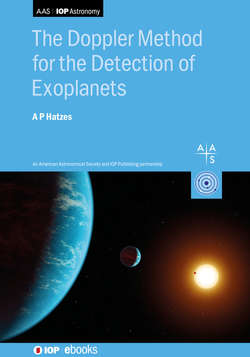Читать книгу The Doppler Method for the Detection of Exoplanets - Professor Artie Hatzes - Страница 49
На сайте Литреса книга снята с продажи.
3.3 RV Precision across Spectral Types
ОглавлениеWe can now put together all we have learned to get a rough estimate of the RV error as a function of Teff, or of the spectral type for main-sequence stars. Using the mean rotational velocity of stars (Table 3.2) and the mean density of lines as a function of Teff results in Figure 3.11. The horizontal dashed line marks an RV precision of 10 m s−1, the nominal value if you want to detect a Jupiter analog around a solar-type star.
Figure 3.11. The expected radial velocity error as a function of spectral type. This was created using the mean rotational velocity and approximate line density for a star in each spectral type. The horizontal line marks the nominal precision of 10 m s−1 needed to detect a Jovian-like exoplanet.
Early RV surveys for planets strove for an initial precision of approximately 10 m s−1, the nominal precision to detect Jupiter analogs. By this criterion, you should not be able to detect planets around stars of early spectral types. Indeed, up until the mid-2000s, the earliest spectral type for which a planet had been detected was about F6. This lack of precision for early stars factored into the biases in the early surveys—investigators simply avoided stars with spectral types earlier than mid-F. It was only in the mid-2000s that RV surveys began to survey more early-type stars (Galland et al. 2005; Hartmann & Hatzes 2015).
Figure 3.11 largely explains the distribution of planet discoveries as a function of spectral type (Figure 3.12). RV surveys largely ignored stars with spectral early than mid-F (Teff≈6000K) due to the poor RV precision. Stars later than about K5 (Teff<4000K) were simply too faint. The early RV surveys were largely performed on 2–3 m class telescopes (Cochran & Hatzes 1993; Butler & Marcy 1997; Queloz et al. 1998), so one could not get good S/N ratios for observations on very cool stars.
Figure 3.12. The distribution of planet detections as a function of the effective temperature of the host star. The distribution roughly coincides with the green shaded region shown in Figure 3.11.
The distribution of RV discoveries also highlights the bias of the technique when it comes to the mass of the host star. On the main sequence, there is a one-to-one mapping between effective temperature and stellar mass. About two-thirds of the host stars of RV-detected planets have effective temperatures in the range 4500–6500 K, and this translates into the narrow mass range of M = 0.7–1.2 M⊙ for the mass of the host star.
We can now put together a grand scaling relationship for the expected RV precision that combines the S/N, the spectral resolving power R, the effective temperature of the star T, and the projected stellar rotational velocity V:
σ[m/s]∝Δλ−1/2S/N−1R−1.2f(V)(0.16e1.79(T/5000)).(3.7)
The function f(V) is given by Equation (3.3).
